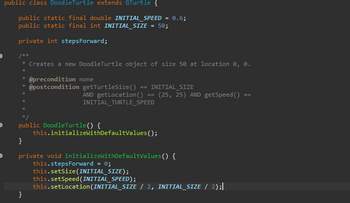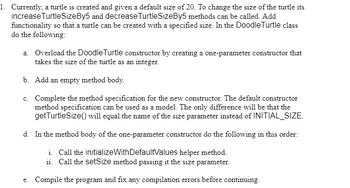
Computer Networking: A Top-Down Approach (7th Edition)
7th Edition
ISBN: 9780133594140
Author: James Kurose, Keith Ross
Publisher: PEARSON
expand_more
expand_more
format_list_bulleted
Question

Transcribed Image Text:public class DoodleTurtle extends GTurtle {
public static final double INITIAL_SPEED = 0.6;
public static final int INITIAL_SIZE = 50;
private int stepsForward;
/**
* Creates a new DoodleTurtle object of size 50 at location 0, 0.
*
* @precondition none
* @postcondition getTurtleSize() == INITIAL SIZE
*
AND getLocation ()
INITIAL_TURTLE_SPEED
}
==
public DoodleTurtle() {
}
private void initializeWithDefaultValues() {
this.stepsForward = 0;
this.initializeWithDefaultValues();
this.setSize(INITIAL_SIZE);
(25, 25) AND getSpeed ()
this.setSpeed (INITIAL_SPEED);
this.setLocation (INITIAL_SIZE / 2, INITIAL_SIZE / 2);|
==

Transcribed Image Text:1. Currently, a turtle is created and given a default size of 20. To change the size of the turtle its
increase TurtleSizeBy5 and decrease TurtleSizeBy5 methods can be called. Add
functionality so that a turtle can be created with a specified size. In the Doodle Turtle class
do the following:
a. Overload the Doodle Turtle constructor by creating a one-parameter constructor that
takes the size of the turtle as an integer.
b. Add an empty method body.
c. Complete the method specification for the new constructor. The default constructor
method specification can be used as a model. The only difference will be that the
getTurtleSize() will equal the name of the size parameter instead of INITIAL_SIZE.
d. In the method body of the one-parameter constructor do the following in this order:
i. Call the initializeWith DefaultValues helper method.
ii. Call the setSize method passing it the size parameter.
e. Compile the program and fix any compilation errors before continuing.
Expert Solution
arrow_forward
Step 1
The answer is given below.
Step by stepSolved in 2 steps with 1 images

Follow-up Questions
Read through expert solutions to related follow-up questions below.
Follow-up Question
So how do you implement the code? Do you just place it anywhere or is it in specific places?
Solution
by Bartleby Expert
Follow-up Questions
Read through expert solutions to related follow-up questions below.
Follow-up Question
So how do you implement the code? Do you just place it anywhere or is it in specific places?
Solution
by Bartleby Expert
Knowledge Booster
Similar questions
- Add a toString method to your Account class. For the purposes of this assignment, please use the toString display the following: This account contains $x. You have earned $y in the last month. where x is the account balance (please don't format the decimals) and y is the monthly interest earned, obtained from the getMonthlyInterest method. Compile and test in a driver by creating and printing an Account object. Add an equals method to your Account class. Two Account objects are equal if their balance and annualInterestRates are equal. Compile and test in your driver by creating 2 Account objects to see if they are equal.arrow_forwardCreate a class Course, which has one field: String courseName Create the constructor, accessor, and mutator for the class. Then, in the main method of this class, create an instance of the class with the name "CST1201". Write an equivalent while statement to replace the following for statement for (int i=2; i<100; i=i+2) { System.out.println(i); }arrow_forwardIn python and include doctring: First, write a class named Movie that has four data members: title, genre, director, and year. It should have: an init method that takes as arguments the title, genre, director, and year (in that order) and assigns them to the data members. The year is an integer and the others are strings. get methods for each of the data members (get_title, get_genre, get_director, and get_year). Next write a class named StreamingService that has two data members: name and catalog. the catalog is a dictionary of Movies, with the titles as the keys and the Movie objects as the corresponding values (you can assume there aren't any Movies with the same title). The StreamingService class should have: an init method that takes the name as an argument, and assigns it to the name data member. The catalog data member should be initialized to an empty dictionary. get methods for each of the data members (get_name and get_catalog). a method named add_movie that takes a Movie…arrow_forward
- Develop a set of classes for a college to use in various student service andpersonnel applications. Classes you need to design include the following:• Person—A Person contains a first name, last name, street address, zip code,and phone number. The class also includes a method that sets each datafield, using a series of dialog boxes and a display method that displays all of aPerson’s information on a single line at the command line on the screenarrow_forwardCreate a class called Player that has the following attributes: Player Health - Integer Intelligence - Integer Dexterity - Integer Strength - Integer Stamina - Integer Player() Player(Health, Intelligence, Dexterity, Strength, Stamina) getHealth() - Integer setHealth(Integer) - Void getIntelligence() - Integer setIntelligence(Integer) - Void getDexterity() - Integer setDexterity(Integer) - Void getStrength() - Integer setStrength(Integer) - Void getStamina() - Integer setStamina(Integer) - Void toString() - String Notes: All attributes should not be allowed to be set below 0.arrow_forwardthis is for a python class 9.12 LAB: Product class In main.py define the Product class that will manage product inventory. Product class has three attributes: a product code, the product's price, and the number count of product in inventory. Implement the following methods: A constructor with 3 parameters that sets all 3 attributes to the value in the 3 parameters set_code(self, code) - set the product code (i.e. SKU234) to parameter code get_code(self) - return the product code set_price(self, price) - set the price to parameter price get_price(self) - return the price set_count(self, count) - set the number of items in inventory to parameter count get_count(self) - return the count add_inventory(self, amt) - increase inventory by parameter amt sell_inventory(self, amt) - decrease inventory by parameter amt Ex. If a new Product object is created with code set to "Apple", price set to 0.40, and the count set to 3, the output is: Name: Apple Price: 0.40 Count: 3 Ex. If 10…arrow_forward
arrow_back_ios
arrow_forward_ios
Recommended textbooks for you
 Computer Networking: A Top-Down Approach (7th Edi...Computer EngineeringISBN:9780133594140Author:James Kurose, Keith RossPublisher:PEARSON
Computer Networking: A Top-Down Approach (7th Edi...Computer EngineeringISBN:9780133594140Author:James Kurose, Keith RossPublisher:PEARSON Computer Organization and Design MIPS Edition, Fi...Computer EngineeringISBN:9780124077263Author:David A. Patterson, John L. HennessyPublisher:Elsevier Science
Computer Organization and Design MIPS Edition, Fi...Computer EngineeringISBN:9780124077263Author:David A. Patterson, John L. HennessyPublisher:Elsevier Science Network+ Guide to Networks (MindTap Course List)Computer EngineeringISBN:9781337569330Author:Jill West, Tamara Dean, Jean AndrewsPublisher:Cengage Learning
Network+ Guide to Networks (MindTap Course List)Computer EngineeringISBN:9781337569330Author:Jill West, Tamara Dean, Jean AndrewsPublisher:Cengage Learning Concepts of Database ManagementComputer EngineeringISBN:9781337093422Author:Joy L. Starks, Philip J. Pratt, Mary Z. LastPublisher:Cengage Learning
Concepts of Database ManagementComputer EngineeringISBN:9781337093422Author:Joy L. Starks, Philip J. Pratt, Mary Z. LastPublisher:Cengage Learning Prelude to ProgrammingComputer EngineeringISBN:9780133750423Author:VENIT, StewartPublisher:Pearson Education
Prelude to ProgrammingComputer EngineeringISBN:9780133750423Author:VENIT, StewartPublisher:Pearson Education Sc Business Data Communications and Networking, T...Computer EngineeringISBN:9781119368830Author:FITZGERALDPublisher:WILEY
Sc Business Data Communications and Networking, T...Computer EngineeringISBN:9781119368830Author:FITZGERALDPublisher:WILEY

Computer Networking: A Top-Down Approach (7th Edi...
Computer Engineering
ISBN:9780133594140
Author:James Kurose, Keith Ross
Publisher:PEARSON

Computer Organization and Design MIPS Edition, Fi...
Computer Engineering
ISBN:9780124077263
Author:David A. Patterson, John L. Hennessy
Publisher:Elsevier Science

Network+ Guide to Networks (MindTap Course List)
Computer Engineering
ISBN:9781337569330
Author:Jill West, Tamara Dean, Jean Andrews
Publisher:Cengage Learning

Concepts of Database Management
Computer Engineering
ISBN:9781337093422
Author:Joy L. Starks, Philip J. Pratt, Mary Z. Last
Publisher:Cengage Learning

Prelude to Programming
Computer Engineering
ISBN:9780133750423
Author:VENIT, Stewart
Publisher:Pearson Education

Sc Business Data Communications and Networking, T...
Computer Engineering
ISBN:9781119368830
Author:FITZGERALD
Publisher:WILEY